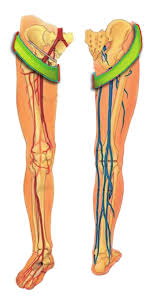Treestand Safety Tips
 The alarm goes off 4:45AM. It’s a chilly morning. It’s the time you’ve waited for all year. Slowly, you make your way to your favorite stand. Dreams from last night start to play in your mind. Your Shooter list bucks begin to parade past you as the darkness gives way to grey light. Excitedly you attached yourself to the tree, begin to ascend the old oak you climbed many times for many years. Once at your platform you tie off securing yourself and begin to get everything situated for the morning hunt. As you lean over to begin to pull your bow up, your right boot slips forwards on the wet metal of the platform propelling you off the stand. “Thud” you hit the tree. Letting out a sigh of relief your safety harness did its job. It kept you alive, stunned but alive you begin to check your arms, legs, head, everything. “Sigh” you’re alive, but now the silent clock begins to tick down like sand through any hourglass…..Are you prepared? Do you know what to do?
The alarm goes off 4:45AM. It’s a chilly morning. It’s the time you’ve waited for all year. Slowly, you make your way to your favorite stand. Dreams from last night start to play in your mind. Your Shooter list bucks begin to parade past you as the darkness gives way to grey light. Excitedly you attached yourself to the tree, begin to ascend the old oak you climbed many times for many years. Once at your platform you tie off securing yourself and begin to get everything situated for the morning hunt. As you lean over to begin to pull your bow up, your right boot slips forwards on the wet metal of the platform propelling you off the stand. “Thud” you hit the tree. Letting out a sigh of relief your safety harness did its job. It kept you alive, stunned but alive you begin to check your arms, legs, head, everything. “Sigh” you’re alive, but now the silent clock begins to tick down like sand through any hourglass…..Are you prepared? Do you know what to do?
The above story, many hunters themselves, friends, or family of them know very well. Having a lifeline and safety harness are paramount to the safe return for all hunters in a treestand. Not having these, is playing a terrible game of odds that no one wins. Something that is commonly overlooked is “what do I do once I’ve fallen and now, I’m hanging here?” Sometimes we can swing around and reach maybe a rung of the ladder of the stand. IF it was indeed a ladder stand. What about a climber, or hang-on. What should or could be done then. Can you reach the steps or sticks? Do you want to leave this area to chance?
What is Suspension Trauma
Suspension trauma (also called Orthostatic Intolerance, or Harness Hang Syndrome) is the loss of consciousness due to a victim being held upright with limited movement for a period, which can rapidly lead to death if not properly recognized and treated (Mohr). In short, what happens is blood begins to pool in your extremities, normally legs, and you can’t adequately supply your brain with sufficient oxygen. Suspension trauma can happen within minutes. So even if you had the harness, the lifeline, and believed you had taken every safety procedure, not preparing for this just as you had everything else could be costly.
What steps can I take to prevent this issue?
 What precautions can you take to prevent or lessen this problem? Many safety harnesses have safety loops suspension relief straps or built in. This loop will allow the suspended individual to “step” into the loop to relieve the pressure and or pooling affect caused by being suspended. Many hunters’ carry a screw in steps in their pocket or the pockets of the harness to always have a way to relieve the pressure. What do you do if you do not have one of these? Keep your legs moving! Move your legs continuously by pushing off from the tree or raise your knees and pump your legs frequently to keep your blood flowing until help arrives.
What precautions can you take to prevent or lessen this problem? Many safety harnesses have safety loops suspension relief straps or built in. This loop will allow the suspended individual to “step” into the loop to relieve the pressure and or pooling affect caused by being suspended. Many hunters’ carry a screw in steps in their pocket or the pockets of the harness to always have a way to relieve the pressure. What do you do if you do not have one of these? Keep your legs moving! Move your legs continuously by pushing off from the tree or raise your knees and pump your legs frequently to keep your blood flowing until help arrives.
In conclusion, we all have dreams of the huge bucks walking past our stand. Giving us the story and memories to last a lifetime. So, if you’re like most hunters, spending countless hours finding the locations, Scouting for the best spot, concealing you and your scent. Make sure treestand safety is in your preparation check list. Gamble on wind directions and stand locations, not your life or the life of the ones you love.
References:
1. Mohr, J. “ASK A PRO: WHAT IS SUSPENSION TRAUMA (AKA HARNESS HANG SYNDROME)?” www.dynamicrescue.com. Web. October 29, 2019
To see more of what Andrew has going on you can follow him on Facebook at Andrew Dick
Be sure to follow everything happening at Cervicide on IG Cervicide and on Youtube at Cervicide


